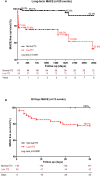Association Between Low T3 Syndrome and Poor Prognosis in Adult Patients With Acute Myocarditis
- PMID: 33763025
- PMCID: PMC7984427
- DOI: 10.3389/fendo.2021.571765
Association Between Low T3 Syndrome and Poor Prognosis in Adult Patients With Acute Myocarditis
Abstract
Background: This study aims to investigate the role of free triiodothyronine (fT3) in predicting poor prognosis of adult patients with acute myocarditis.
Methods: A total of 173 consecutive adult patients with acute myocarditis completed thyroid function evaluations. They were divided into two groups according to fT3 levels: low fT3 group (n = 54, fT3 < 3.54 pmol/liter) and normal fT3 group (n = 119, fT3 ≥ 3.54 pmol/liter). The primary endpoint was major adverse cardiac events (MACE).
Results: During the 3.5 ± 2.8 years follow-up, the rate of MACE was 29.6% versus 3.5% in low fT3 group versus normal fT3 group, respectively (P < 0.0001). Long-term at 8 years MACE-free survival were lower in low fT3 group versus normal fT3 group (52.9% versus 92.3%, log-rank P < 0.0001), respectively. Univariate Cox analysis showed that left ventricular ejection fraction (LVEF) < 50% [hazard ratio (HR) 10.231, 95% confidence interval (CI): 3.418-30.624, P < 0.0001) and low fT3 level (HR 0.360, 95% CI: 0.223-0.582, P < 0.0001) were strongest two predictors of MACE. After adjustment for traditional risk predictors, the prognostic value of fT3 status was still significant (HR 0.540, 95% CI: 0.316-0.922, P = 0.024). Compared with normal fT3 group, those in low fT3 group were at a much higher risk of MACE (HR 5.074, 95% CI: 1.518-16.964, P = 0.008).
Conclusions: Low T3 syndrome was a strong predictor of poor prognosis in adult patients with acute myocarditis. These findings suggest that fT3 level could serve as a biomarker for risk stratification in acute myocarditis patients.
Keywords: acute myocarditis; adult; low T3 syndrome; predictor; prognosis.
Copyright © 2021 Zhao, Wang, Zhang and Tang.
Conflict of interest statement
The authors declare that the research was conducted in the absence of any commercial or financial relationships that could be construed as a potential conflict of interest.
Figures





Similar articles
-
Low T3 syndrome is associated with 30-day mortality in adult patients with fulminant myocarditis.Front Endocrinol (Lausanne). 2023 May 31;14:1164444. doi: 10.3389/fendo.2023.1164444. eCollection 2023. Front Endocrinol (Lausanne). 2023. PMID: 37324269 Free PMC article.
-
[Impact of low T3 syndrome on adverse cardiovascular events in adult patients with acute viral myocarditis].Zhonghua Xin Xue Guan Bing Za Zhi. 2019 Jun 24;47(6):447-451. doi: 10.3760/cma.j.issn.0253-3758.2019.06.005. Zhonghua Xin Xue Guan Bing Za Zhi. 2019. PMID: 31262128 Chinese.
-
Analysis of the Incidence of Euthyroid Sick Syndrome in Comprehensive Intensive Care Units and Related Risk Factors.Front Endocrinol (Lausanne). 2021 Jun 9;12:656641. doi: 10.3389/fendo.2021.656641. eCollection 2021. Front Endocrinol (Lausanne). 2021. PMID: 34177801 Free PMC article.
-
Association of triiodothyronine levels with left ventricular function, cardiovascular events, and mortality in hemodialysis patients.Int J Artif Organs. 2017 Mar 16;40(2):60-66. doi: 10.5301/ijao.5000569. Epub 2017 Feb 28. Int J Artif Organs. 2017. PMID: 28315504
-
[Thyroid hormones disturbances in critical ill patients--low T3 syndrome].Pol Arch Med Wewn. 2005 Dec;114(6):1260-6. Pol Arch Med Wewn. 2005. PMID: 16789498 Review. Polish. No abstract available.
Cited by
-
Fulminant Giant Cell Myocarditis vs. Lymphocytic Myocarditis: A Comparison of Their Clinical Characteristics, Treatments, and Outcomes.Front Cardiovasc Med. 2021 Dec 3;8:770549. doi: 10.3389/fcvm.2021.770549. eCollection 2021. Front Cardiovasc Med. 2021. PMID: 34926619 Free PMC article.
-
Low T3 syndrome is associated with 30-day mortality in adult patients with fulminant myocarditis.Front Endocrinol (Lausanne). 2023 May 31;14:1164444. doi: 10.3389/fendo.2023.1164444. eCollection 2023. Front Endocrinol (Lausanne). 2023. PMID: 37324269 Free PMC article.
-
Low Free Triiodothyronine as a Predictor of Poor Prognosis in Patients With Myocardial Infarction With Non-Obstructive Coronary Arteries.Front Endocrinol (Lausanne). 2021 May 31;12:681978. doi: 10.3389/fendo.2021.681978. eCollection 2021. Front Endocrinol (Lausanne). 2021. PMID: 34135864 Free PMC article.
-
Low T3 syndrome as a predictor of poor prognosis in peripheral T-cell lymphomas.Clin Transl Oncol. 2024 Mar;26(3):613-622. doi: 10.1007/s12094-023-03280-9. Epub 2023 Jul 18. Clin Transl Oncol. 2024. PMID: 37460749
-
Impact of heart rate on the outcome of hypothermic patients.J Rural Med. 2025 Apr;20(2):88-91. doi: 10.2185/jrm.2024-016. Epub 2025 Apr 1. J Rural Med. 2025. PMID: 40182156 Free PMC article.
References
Publication types
MeSH terms
Substances
LinkOut - more resources
Full Text Sources
Other Literature Sources

